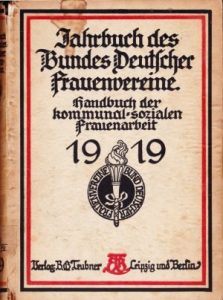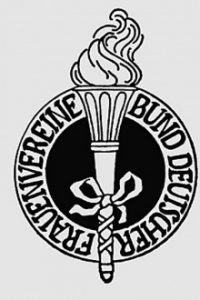Federation of German Women’s Associations (Bund Deutscher Frauenvereine, BDF) (1894-1933)
“The demands of the women’s movement are based on the existence of thoroughgoing mental and physical differences between the sexes. It deduces from this fact that only by the cooperation of men and women can all the possibilities of cultural progress be realized.” – BDF Program
Federation of German Women’s Associations (Bund Deutscher Frauenvereine, BDF) was founded in 1894 as an umbrella organization of the middle and upper-class women’s movement in Germany and existed until the Nazis came to power in January 1933. As an association it sought to unite women’s groups with different political, social and religious background and agenda from the liberal to the national-conservative political spectrum. It did not welcome the social democratic women’s organization, founded in 1891, in its ranks. The BDF grew quickly before 1914: In 1895 it had 65 chapters, in 1901 already 137 with 70,000 members and in 1913 more than 2200 chapters with 500,000 members. It became one or the largest women’s organizations in Europe before the First World War.
The social and political composition of the BDF influenced its politics. The BDF was more focused on charitable causes related to the ‘women’s sphere.’ It members pressured for a wide range of issues including equal rights in family and marriage, equal access to education and social reform. They also demanded equal political rights with men. In 1910, Gertrud Bäumer was named president of the BDF. Her election was the result of maneuvers by Bäumer’s close friend Helene Lange, who worked to oust the former president Marie Stritt, who she saw as politically too radical. One issue of the conflict in the BDF was the question which form suffrage right it should support: equal suffrage with men or universal suffrage for all men and women, including working class men and women. Another issue of conflict were women’s reproductive rights. Bäumer and other national-liberal and conservative women denounced feminists in the ranks of the BDF, who supported a liberalization of the prohibition of birth control and abortion in the Penal Code of 1871. With the onset of the First World War, Bäumer also denounced women’s groups who opposed the war and supported pacifism. She pushed the BDF to actively support the war effort. Gertrud Bäumer served as BDF president for nine years, although she excreted major influence over the organization for over twenty through her editorship of the BDF journal Die Frau (The Woman), published since 1894. Under her leadership, the organization became steadily more conservative, a trend that continued during the Weimar Republic. After the Nazi Party came into Power in January 1933, the BDF leadership decided to dissolve the organization, before it was disband like all other non-religious women’s groups, and replaced by the general Nazi women’s organization, the German Women’s Front (Deutsche Frauenfront).
During its existence, the Federation of German Women’s Associations worked to unite many different smaller organizations that were working towards a common goal, women’s education and rights. Although these different groups each had their own specific stated purpose or represented different parts of population, the BDF provided a forum for these women to assemble, pool their resources, and let their voices reach a wider audience. The model the BDF used to organize and efficiently manage these different associations could be replicated by similar groups today. Modern day organizations could also take note of the strong moral convictions of leaders of the BDF, like Gertrud Bäumer who refused to surrender the names of the Jewish members to the Nazi regime.
About the Author of This Entry
Chloe Gruesbeck, Political Science and Contemporary European Studies, Class of 2020
Sources
Literature and Websites
- “Bäumer, Gertrud (1873–1954).” Women in World History: A Biographical Encyclopedia, 2002. https://www.encyclopedia.com/women/encyclopedias-almanacs-transcripts-and-maps/baumergertrud-1873-1954 (Accessed April 12, 2018).
- Schaser, Angelika. “Bäumer, Gertrud.” International Encyclopedia of the First World War, at: https://encyclopedia.1914-1918-online.net/article/baumer_gertrud (Accessed April 12, 2018).
- Guido, Diane J. The German League for the Prevention of Women’s Emancipation: Anti-Feminism in Germany, 1912-1920. Frankfurt am Main: Peter Lang, 2010.
- Greven-Aschoff, Barbara. Die bürgerliche Frauenbewegung in Deutschland 1894–1933. Vandenhoeck & Ruprecht, Göttingen 1981.
Images


